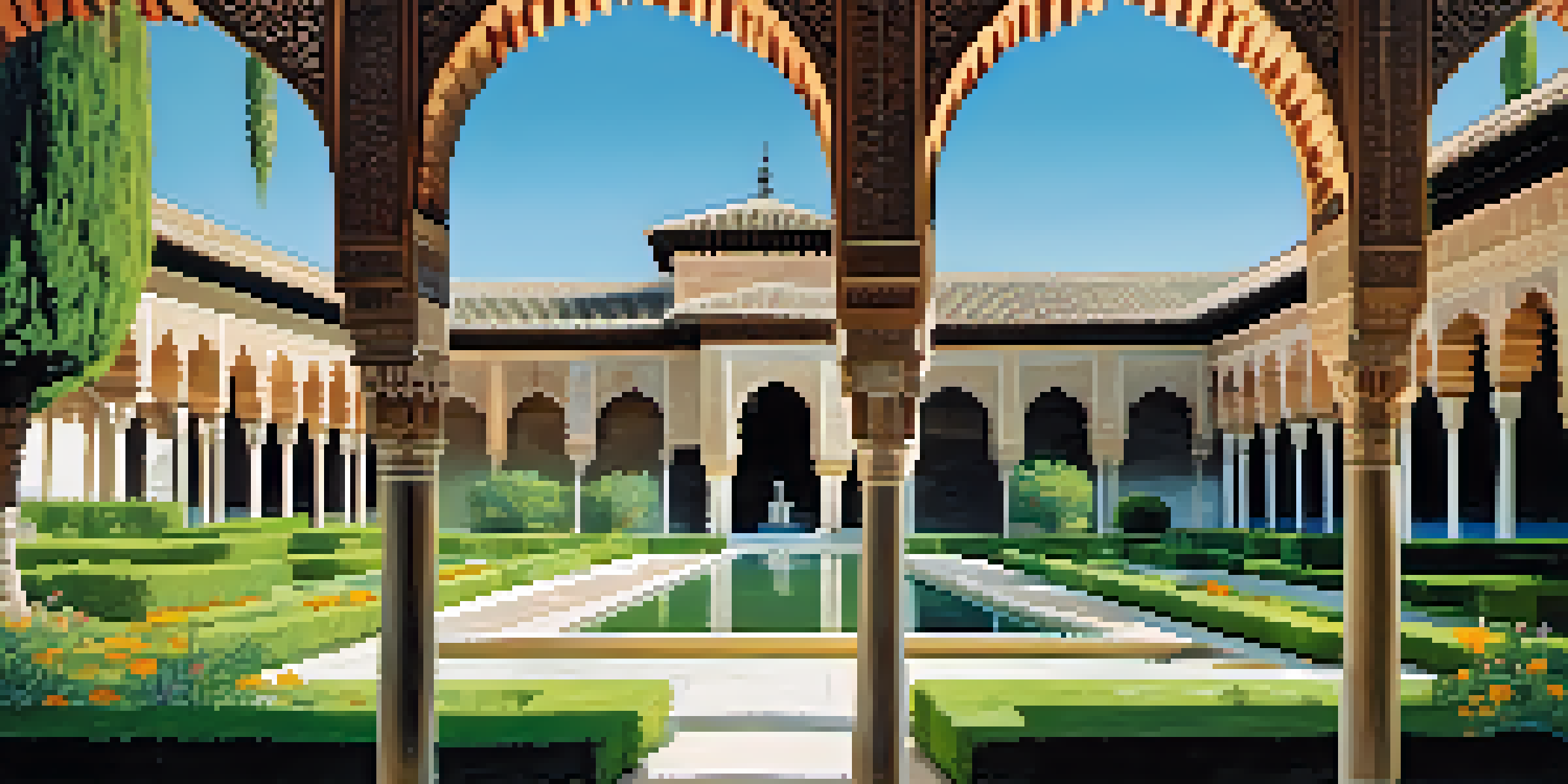Spain's Rich Cultural Heritage: Importance of Conservation Efforts

Understanding Spain's Diverse Cultural Heritage
Spain is a tapestry of cultures, woven from its rich history and varied regions. From the Moorish architecture of Andalusia to the modernist influences of Catalonia, each area boasts its own unique identity. This diversity reflects centuries of influences, including Roman, Islamic, and Christian elements, making Spain a cultural treasure.
Cultural heritage is the foundation of our identity; it is essential to preserve it for future generations.
The country's heritage is not just in its buildings and monuments; it's also found in its traditions, languages, and festivals. Flamenco dancing, the running of the bulls, and regional cuisine are just a few examples of how culture expresses itself in everyday life. Each tradition tells a story, connecting the past with the present.
Preserving this cultural wealth is essential, as it fosters national pride and promotes tourism. It also serves as a bridge to understanding and appreciating the nuances of Spanish identity, which is crucial in a world that often seeks to homogenize distinct voices.
The Role of Conservation in Cultural Heritage
Conservation refers to the efforts made to protect, preserve, and restore cultural artifacts and sites. In Spain, these efforts are vital to maintaining the integrity of historical landmarks and artworks that have stood the test of time. Without proper conservation, many of these treasures risk deterioration or loss.

Organizations and local governments play a significant role in conservation, often collaborating with international bodies. They focus on various aspects, including structural integrity, environmental impact, and community involvement, ensuring that preservation is a holistic endeavor. This collaborative approach helps to share knowledge and resources, making conservation more effective.
Cultural Diversity in Spain
Spain's rich cultural heritage is shaped by various historical influences, reflected in its traditions, languages, and regional identities.
Moreover, conservation efforts often spark greater interest and awareness among the public. When people see the importance of protecting their cultural heritage, they are more likely to engage with it, whether through volunteering, attending events, or simply learning more about their history.
Challenges Facing Spain's Cultural Heritage
Despite the rich cultural landscape, Spain faces numerous challenges in conservation. Urbanization, climate change, and neglect threaten many historical sites and traditions. For instance, increasing tourism can lead to wear and tear on popular sites, while lack of funding can hinder restoration projects.
The past is not dead; it is living in us, and will be alive in the future generation.
Additionally, some cultural practices are at risk of disappearing as younger generations migrate to urban centers or adopt global trends. This shift can lead to a loss of traditional crafts and languages, which are integral to Spain's cultural fabric. The challenge lies in balancing modern development with the preservation of these cherished practices.
Addressing these challenges requires a concerted effort from all stakeholders, including government, community members, and tourists. By fostering a sense of responsibility towards cultural heritage, everyone can contribute to its preservation for future generations.
Success Stories in Spanish Cultural Conservation
Spain has seen several successful conservation projects that serve as inspiring examples. One notable instance is the restoration of the Alhambra in Granada, which involved meticulous attention to detail in preserving its intricate Moorish architecture. This iconic site attracts millions of visitors each year, showcasing how effective conservation can enhance cultural appreciation.
Another success story is the revival of traditional Spanish crafts, such as pottery and weaving. Community workshops and festivals have been organized to teach younger generations these skills, ensuring they are passed down. Such initiatives not only preserve the craft but also create economic opportunities for local artisans.
Importance of Conservation Efforts
Conservation is crucial for preserving Spain's historical sites and traditions, fostering national pride and promoting cultural tourism.
These examples highlight the importance of ongoing commitment to conservation efforts. They demonstrate that when communities come together to protect their heritage, they not only save their culture but also strengthen their identity and pride.
Community Involvement in Cultural Heritage Conservation
Community involvement is crucial for effective cultural conservation. Local residents often possess invaluable knowledge about their heritage, making their input essential in conservation efforts. Engaging communities fosters a sense of ownership and responsibility towards their cultural assets, encouraging more proactive preservation.
Various initiatives, such as workshops, educational programs, and volunteer opportunities, have been developed to involve the community. For example, local heritage groups often organize clean-up days or restoration projects, allowing residents to actively participate in preserving their history. These activities not only benefit the sites but also strengthen community ties.
Moreover, community-led conservation projects can lead to innovative solutions that reflect local needs and values. By combining traditional knowledge with modern practices, communities can create unique approaches to preserving their cultural heritage while adapting to contemporary challenges.
The Economic Impact of Cultural Heritage Conservation
Cultural heritage conservation plays a significant role in boosting local economies. By preserving historical sites and promoting cultural tourism, communities can attract visitors eager to experience Spain's rich history. This influx of tourists can lead to increased revenue for local businesses, from restaurants to souvenir shops.
Moreover, conservation projects often create job opportunities, ranging from restoration specialists to tour guides. Such jobs not only provide economic benefits but also help in fostering a deeper understanding of local culture among those employed. This connection can enhance the visitor experience and promote sustainable tourism.
Community Engagement in Heritage
Involving local communities in conservation efforts enhances their sense of ownership and leads to innovative solutions for preserving cultural heritage.
In essence, investing in cultural heritage conservation is a win-win scenario. It preserves the past while simultaneously creating economic opportunities for the present, ensuring that both culture and community thrive together.
Future Directions for Spain's Cultural Heritage Conservation
Looking ahead, the future of Spain's cultural heritage conservation hinges on innovation and collaboration. Embracing new technologies can enhance preservation techniques, making it easier to monitor and maintain historical sites. For example, using 3D scanning and virtual reality can provide new ways to document and experience cultural heritage.
Furthermore, fostering international partnerships can help share best practices and resources. By learning from other countries' experiences in conservation, Spain can adopt successful strategies while tailoring them to its unique cultural context. This collaborative approach can lead to more effective and sustainable conservation efforts.

Ultimately, the success of conservation efforts will depend on raising awareness and engaging the public. By highlighting the importance of cultural heritage and encouraging active participation, we can ensure that Spain's rich cultural legacy is preserved for generations to come.